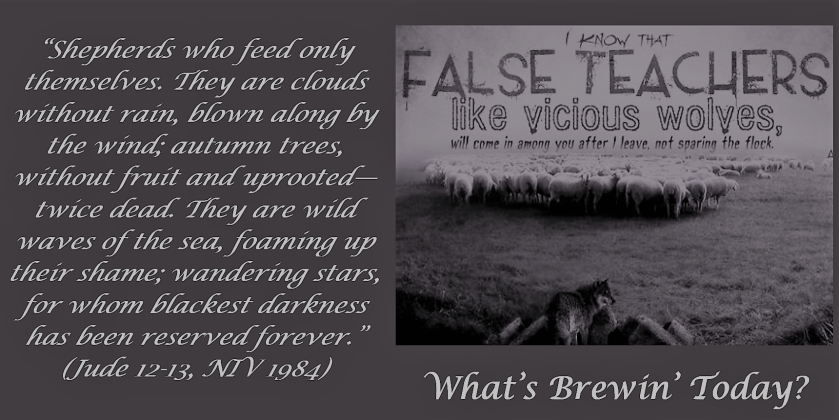
My Musings – In banking, tellers are taught the best way to spot a counterfeit – you study the genuine article. By being familiar with the “real deal” you can more readily spot the fake. This similar principle can be applied to identifying false teachers. You look to what they are saying and doing, and you place it alongside what is truth – God’s Word.
Feed Only Themselves – We’ve all seen them, enriching themselves while the flock is starving for the truth.
Clouds Without Rain – They look and sound impressive, but in reality lack the substance of the truth.
Autumn Trees Without Fruit – You expect the fruit in the Autumn, and you would expect spiritual leaders to bear real fruit. Yet the false ones pander to big crowds in this age of “consumer Christianity.” Give them what they want to hear, not what they need to hear.
Wild Waves Foaming Up – Stirring the pot, when they should be building up the body in unity of the Spirit.
Wandering Stars – Abandoning the flock that they have been entrusted with, seeking greener pastures for themselves, while their sheep are left shepherd less.
For Whom Blackest Darkness Has Been Reserved Forever – Their just reward.
My Advice – Stay in the Word. You’ll know who measures up and who does not. Here are a few pointers.
1. Is the teaching from a well-known and trusted source?
“But as for you, continue in what you have learned and have become convinced of, because you know those from whom you learned it, and how from infancy you have known the Holy Scriptures.” (2 Timothy 3:14, 15)
2. Is the teaching consistent with what you have learned from the well-known and trusted sources?
“I urge you brothers, to watch out for those who cause divisions and put obstacles in your way that are contrary to the teaching you have learned.” (Romans 16:17)
3. Is the teaching clear from the texts or is the interpretation strained?
“You strain out a gnat but swallow a camel.” (Matthew 23:24)
4. Is the teaching exclusive or nearly exclusive?
“Above all, you must understand that no prophecy of scripture came about by the prophet’s own interpretation.” (2 Peter 1:20)
5. Is the teaching necessary to support a questionable position or lifestyle?
“For the time will come when men will not put up with sound doctrine. Instead, to suit their own desires, they will gather around them a great number of teachers to say what their itching ears want to hear.” (2 Timothy 4:3)
6. Does the teaching direct society to follow God’s moral standards or does the teaching encourage others to follow the world’s social mores?
“Do not be overcome by evil, but overcome evil with good.” (Romans 12:21)
7. Is the teaching’s emphasis on grace and freedom too permissive?
“You my brothers, were called to be free. But do not use your freedom to indulge the sinful nature.” (Galatians 5:13)
8. Is the teaching’s emphasis on morality and obedience too repressive?
“Woe to you, blind guides! You say, ‘If anyone swears by the temple, it means nothing; but if anyone swears by the gold of the temple, he is bound by the oath.’ You blind fools!” (Matthew 23:16, 17)
9. Does the teaching deny the power of God to enable His children to overcome sin and temptation?
“And that is what some of you were. But you were washed, you were sanctified, you were justified in the name of the Lord Jesus Christ and by the Spirit of the Lord.” (1 Corinthians 6:11)
10. Does the teaching follow Satan’s pattern of masquerading as an angel of light?
“For such men are false apostles of Christ. And no wonder, for Satan himself masquerades as an angel of light. It is not surprising then, if his servants masquerade as servants of righteousness.” (1 Corinthians11:13, 14)
11. Does the teaching follow Satan’s pattern of deceit by calling God’s Word into question?
“Now the serpent was more crafty than any of the wild animals the Lord God had made. He said to the woman, “Did God really say….” (Genesis 3:1)
12. Does the teaching call right wrong and wrong right?
“Woe to those who call evil good and good evil, who put darkness for light and light for darkness, who put bitter for sweet and sweet for bitter.” (Isaiah 5:20)
Mark Twain is credited with saying that “in religion and politics people’s beliefs and convictions are in almost every case gotten at second-hand, and without examination, from authorities who have not themselves examined the questions at issue but have taken them at second-hand from other non-examiners, whose opinions about them were not worth a farthing.” We must never be too lazy (or too naïve) to blindly accept every “wind of doctrine” that comes along. In the final analysis, even when the source of information seems trustworthy, like the Bereans, we must lay what is being said alongside the Word of God to see if it is true. However, in order to do this effectively we must be sufficiently familiar with the Bible to know how to use it. Possessing a tool is not much good if we do not know how to use (“rightly divide”) it properly.


Amen to that sir! God bless!
LikeLiked by 2 people
Right back at you bro’
LikeLike
Reblogged this on The Brew Is A Musing and commented:
Reblog from September 26, 2019. How to recognize fake good news.
LikeLike